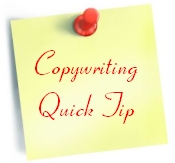 Time for another lesson in copywriting! Today, you’ll learn a critical element of every copywriting project you take on that you should memorize and never forget — when it comes to making purchase decisions, consumers care about themselves.
Time for another lesson in copywriting! Today, you’ll learn a critical element of every copywriting project you take on that you should memorize and never forget — when it comes to making purchase decisions, consumers care about themselves.
When I teach copywriting to business owners, I always start off this section of the lesson with a sentence that quickly catches their attention, “No one cares about you.” They don’t like to hear this news from me, but if they can’t understand it, their marketing messages will fail to deliver the results they want and need.
So how does this apply to the copy that you write for clients (or to market your own freelance writing business)?
It provides you with a very simple rule that you should always follow: Your copy should include far more references to ‘you’ than ‘we’ or ‘me’.
Let me explain.
When a consumer reads copy, they want to hear how the product or service being marketed will help them. They need to understand that the money they pay for that product or service will make their lives better or easier. In other words, they need to believe that the product or service will benefit them in some way that is worth the monetary investment and time required to make a purchase. They don’t care about the fact a business is a member of the local Chamber of Commerce. No matter how proud a business owner is about his longstanding membership, that piece of information is not going to close a sale. When a business has limited space or time to communicate messages to consumers, that space needs to be used as effectively as possible in order to compel consumers to action.
Bottom-line, don’t clutter copy with references to ‘me’ and ‘we’ (i.e., the business talking about itself). Instead, fill your copy with references to ‘you’ (i.e., the consumer) so they can relate to the messages and apply them to their own lives. Following are two simple examples for a computer retailer to help you understand this concept:
- We or Me Copy: We offer low prices and our employees are experts in the computers we sell.
- You Copy: You’ll get low prices and personal service from a staff that’s ready to help you find the computer that’s right for you.
As a consumer looking for a computer, which of the above copy examples is more compelling to you? The first is loaded with references to ‘we’ while the second is all about ‘you’, the customer. Clearly, the second example would be more effective at moving consumers to action.
The rule-of-thumb that I suggest following is the 80-20 rule of marketing that tells us 80% of a company’s business comes from 20% of its customers. By applying that rule to copywriting, 80% of your copywriting should refer to ‘you’ while just 20% should refer to ‘we’ or ‘me’. Of course, there are exceptions to every rule, but follow this guideline to achieve a good balance, and your copywriting will improve. You can read more about the you not we rule in my book, Kick-ass Copywriting in 10 Easy Steps.
Click to read previous lessons from the Lessons in Copywriting series.


Leave a Reply